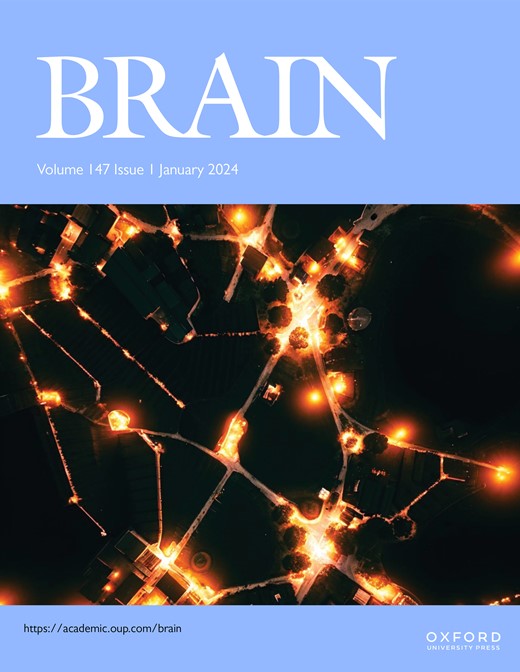Early proteasome downregulation and dysfunction drive proteostasis failure in Alzheimer’s disease
IF 11.7
1区 医学
Q1 CLINICAL NEUROLOGY
引用次数: 0
Abstract
Alzheimer’s disease (AD) is characterized by the accumulation of pathogenic proteins, notably amyloid-beta and hyperphosphorylated tau, which disrupt neuronal function and contribute to cognitive decline. Although proteotoxic stress is well-established in AD, the role of the ubiquitin-proteasome system (UPS) in maintaining neuronal proteostasis, and how it becomes compromised during disease progression remains incompletely understood. Here we integrated multiple approaches to characterize proteasome function, composition, and regulation in post-mortem human AD brain tissue compared to age-matched controls. These included proteasome kinetic assays, affinity purification of intact 26S proteasomes, in-gel activity assays and proteomics. According to Braak staging, we further interrogated bulk RNA-seq and single-nucleus RNA-seq (sn-RNA-seq) datasets spanning the progression of AD pathology. Finally, we examined Nrf1/NFE2L1 binding and subcellular localization to understand the transcriptional regulation of proteasome genes in AD. We found that proteasome activity is significantly impaired in AD brains, affecting both 26S and 20S complexes. This reduction in proteolytic capacity persisted after proteasome purification, implicating intrinsic defects within the proteasome complex. Proteomic profiling of isolated proteasomes revealed diminished abundances of constitutive proteasome complexes and the co-purification of proteasomes with aggregation-prone substrates (e.g., tau, α-synuclein and SQSTM1/p62), suggesting proteasome entrapment in pathological aggregates. Transcriptomic analyses showed progressive downregulation of constitutive proteasome subunit genes in individuals along the Braak stage axis, with downregulation apparent even at the earliest Braak stages, in tissue without overt tau aggregation. Neurons were disproportionately affected, whereas non-neuronal cells did not show substantial differences in proteasome-related gene expression, possibly through immunoproteasome induction. Despite elevated NFE2L1 expression, a key transcription factor normally driving proteasome gene transcription, AD brains exhibited impaired Nrf1 nuclear localization, preventing the expected compensatory upregulation of proteasome components. Collectively, our findings suggest that proteasome dysfunction in AD arises early and deepens over the disease course. Intrinsic alterations in proteasome complexes, coupled with early transcriptional downregulation of proteasome subunits and disrupted Nrf1-mediated regulatory pathways, contribute to a vicious cycle of proteotoxic stress and neuronal vulnerability. Restoring proteasome function and enhancing Nrf1-driven transcriptional responses may represent promising therapeutic strategies to preserve proteostasis and mitigate neurodegeneration in AD.早期蛋白酶体下调和功能障碍驱动阿尔茨海默病的蛋白质平衡失败
阿尔茨海默病(AD)的特点是致病性蛋白的积累,尤其是淀粉样蛋白- β和过度磷酸化的tau蛋白,它们会破坏神经元功能并导致认知能力下降。尽管蛋白质毒性应激在阿尔茨海默病中得到了证实,但泛素-蛋白酶体系统(UPS)在维持神经元蛋白质平衡中的作用,以及它在疾病进展过程中如何受到损害,仍然不完全清楚。在这里,我们整合了多种方法来表征死后人类AD脑组织中蛋白酶体的功能、组成和调节,并与年龄匹配的对照组进行了比较。这些包括蛋白酶体动力学分析、完整26S蛋白酶体的亲和纯化、凝胶内活性分析和蛋白质组学。根据Braak分期,我们进一步询问了跨越AD病理进展的大量RNA-seq和单核RNA-seq (sn-RNA-seq)数据集。最后,我们检测了Nrf1/NFE2L1结合和亚细胞定位,以了解AD中蛋白酶体基因的转录调控。我们发现AD大脑中蛋白酶体活性明显受损,影响26S和20S复合物。蛋白酶体纯化后,这种蛋白水解能力的降低持续存在,暗示蛋白酶体复合体存在内在缺陷。分离的蛋白酶体的蛋白质组学分析显示,组成性蛋白酶体复合物的丰度降低,蛋白酶体与易于聚集的底物(如tau, α-synuclein和SQSTM1/p62)的共同纯化,表明蛋白酶体在病理聚集中被包裹。转录组学分析显示,在个体中,组成性蛋白酶体亚基基因沿着Braak期轴逐渐下调,即使在Braak期早期,在没有明显tau聚集的组织中,下调也很明显。神经元受到不成比例的影响,而非神经元细胞在蛋白酶体相关基因表达方面没有表现出实质性差异,可能是通过免疫蛋白酶体诱导。尽管正常情况下驱动蛋白酶体基因转录的关键转录因子NFE2L1表达升高,但AD大脑显示Nrf1核定位受损,阻止了预期的蛋白酶体成分代偿上调。总的来说,我们的研究结果表明,AD的蛋白酶体功能障碍早期出现,并在疾病过程中加深。蛋白酶体复合物的内在改变,加上蛋白酶体亚基的早期转录下调和nrf1介导的调节途径的中断,导致了蛋白质毒性应激和神经元易损性的恶性循环。恢复蛋白酶体功能和增强nrf1驱动的转录反应可能是保持AD蛋白平衡和减轻神经退行性变的有希望的治疗策略。
本文章由计算机程序翻译,如有差异,请以英文原文为准。
求助全文
约1分钟内获得全文
求助全文
来源期刊

Brain
医学-临床神经学
CiteScore
20.30
自引率
4.10%
发文量
458
审稿时长
3-6 weeks
期刊介绍:
Brain, a journal focused on clinical neurology and translational neuroscience, has been publishing landmark papers since 1878. The journal aims to expand its scope by including studies that shed light on disease mechanisms and conducting innovative clinical trials for brain disorders. With a wide range of topics covered, the Editorial Board represents the international readership and diverse coverage of the journal. Accepted articles are promptly posted online, typically within a few weeks of acceptance. As of 2022, Brain holds an impressive impact factor of 14.5, according to the Journal Citation Reports.
 求助内容:
求助内容: 应助结果提醒方式:
应助结果提醒方式:


